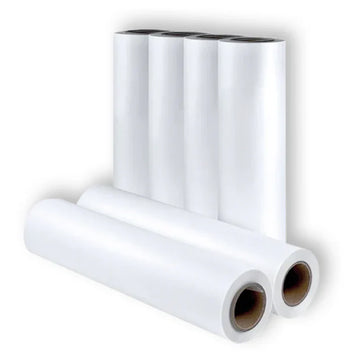TL;DR
Your choice of DTF film impacts print quality, speed, and wash durability. Learn the key differences between hot peel, cold peel, and double-matte films, and find out how to select the right one for your business.

1) What Is DTF Film?
DTF Film is the foundation of Direct-to-Film printing. It’s a special PET (Polyester) carrier film with a coating that holds printed ink and allows a TPU hot-melt powder to bond to it. During heat transfer, the film releases cleanly, leaving a durable design on your fabric.
But not all films are the same. The type, coating, thickness, and peel properties all affect your end results—whether you're printing small runs or high-volume orders.
2) Types of DTF Film: Hot, Cold, and Warm Peel
The peel type determines when you remove the film after pressing. This impacts everything from speed to detail quality and overall durability.
🔥 Hot Peel Film
-
Peel immediately after pressing.
-
Best for: Fast, high-volume prints and simple designs.
-
Advantages: Quick and easy workflow.
-
Challenges: Requires careful peel technique to avoid incomplete transfers or lifting.
❄️ Cold Peel Film
-
Peel after cooling to room temperature.
-
Best for: Detailed designs, small text, and fine lines.
-
Advantages: Better for micro details and high-fidelity prints.
-
Challenges: Slightly slower due to cooling time.
🌤️ Warm Peel Film
-
Peel when the film is warm but not hot.
-
Best for: Balanced between speed and detail.
-
Advantages: A great middle-ground option.
-
Challenges: Not as forgiving as cold peel for delicate designs.
3) Film Coatings: Double-Matte vs Single-Matte
-
Double-matte anti-static films provide the best feed stability, less static, and fewer dust spots. Perfect for smooth operations, especially in busy shops.
-
Single-matte films are usually faster to feed but can accumulate static and dust. These are generally fine for simpler designs or fewer runs.
Tip: If you’re in a high-volume shop, always choose double-matte anti-static for more consistent prints.
4) DTF Film Thickness: 75µm vs 100µm
Thickness plays a key role in your film’s flexibility and feeding behavior. The thinner the film, the more flexible it is, but also more prone to curling or shifting.
| Spec | 75µm | 100µm |
|---|---|---|
| Flexibility | More flexible | Stiffer and more stable |
| Curl Resistance | More prone to curl | Less curl, more consistent feed |
| Use Case | Small shops, light-medium runs | High-volume shops, wide-format prints |
| Registration | Good | Excellent for long prints |
Tip: Choose 75µm if you're printing smaller designs or using a smaller press. For high-volume or wide-format printing, go with 100µm for better feed stability.
5) How to Choose the Right Film for Your Shop
Choosing the right DTF film depends on your workflow, fabric type, and production volume. Here's a quick guide to make it easy:
| Feature | Hot Peel | Cold Peel | Warm Peel |
|---|---|---|---|
| Speed | Fast | Slower | Middle ground |
| Best for | High-volume, simple graphics | Small text, fine details, dark fabrics | General use |
| Best Peel Type | Quick and confident | Best for intricate prints | Safe and balanced |
Tip: If you’re in high-volume production, go with hot peel films. For fine details (like small fonts or logos), use cold peel.
6) Fabric Pairing and Press Settings
Once you've chosen the right film, make sure you adjust your press settings accordingly.
| Fabric Type | Hot Peel | Cold Peel | Warm Peel |
|---|---|---|---|
| Cotton/Poly | 155–160°C, 10–12s | 150–155°C, 12–15s | 155°C, 12–15s |
| Stretch Fabrics | 150°C, 15–18s | 145°C, 18–20s | 150°C, 15–18s |
| Textured (Fleece/Denim) | 160°C, 15–18s | 155°C, 18–20s | 160°C, 15–18s |
Pro Tip: Pre-press garments for 3–5 seconds to eliminate wrinkles and moisture for more even powder bonding.
7) How to Avoid Common Film Issues
Here’s a quick troubleshooting guide for when things go wrong with your film:
| Issue | Likely Cause | Fix |
|---|---|---|
| Peeling Issues | Incorrect peel type or low pressure | Increase pressure or try a cold peel for better detail retention |
| Poor Color or Opacity | Under-cured powder or low ink saturation | Increase curing time/temperature and use more ink |
| Film Curling | Thin film (75µm) or too high humidity | Switch to thicker (100µm) film or control environment humidity |
8) Boost Quality and Save Time: DTF Film Tips for Success
-
Pre-press garments to remove moisture.
-
Test new film and ink combos before full runs.
-
Always use double-matte anti-static films in high-volume shops.
-
For detailed designs, go for cold peel for the best edge quality.
✅ Why Choose KungFuDTF?
We offer a wide range of DTF films with hot peel, cold peel, and double-matte options, tested to deliver crisp prints, fast turnarounds, and minimal errors. Get in touch for bulk orders or sample rolls today!






